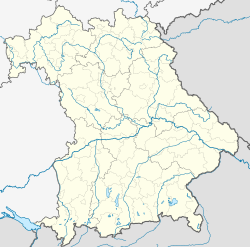world.wikisort.org - Germany
Fahrenzhausen is a municipality located on the river Amper in the district of Freising in Bavaria in Germany. The town is about 30 Kilometers north of Munich.
This article uses bare URLs, which are uninformative and vulnerable to link rot. (September 2022) |
Fahrenzhausen | |
|---|---|
Municipality | |
 Town hall | |
 Coat of arms | |
Location of Fahrenzhausen within Freising district  | |
 Fahrenzhausen  Fahrenzhausen | |
| Coordinates: 48°21′N 11°33′E | |
| Country | Germany |
| State | Bavaria |
| Admin. region | Oberbayern |
| District | Freising |
| Government | |
| • Mayor (2020–26) | Heinrich Stadlbauer[1] |
| Area | |
| • Total | 37.64 km2 (14.53 sq mi) |
| Elevation | 465 m (1,526 ft) |
| Population (2020-12-31)[2] | |
| • Total | 5,067 |
| • Density | 130/km2 (350/sq mi) |
| Time zone | UTC+01:00 (CET) |
| • Summer (DST) | UTC+02:00 (CEST) |
| Postal codes | 85777 |
| Dialling codes | 08133 |
| Vehicle registration | FS |
| Website | www.fahrenzhausen.de |
Geography
Fahrenzhausen has several villages in its community: Appercha, Bachenhausen, Bergfeld, Grosseisenbach, Grossnöbach, Jarzt, Kammerberg, Lauterbach, Unterbruck, Viehbach and Weng.
The areas around Fahrenzhausen consists of small rivers, creeks, marshland, forests and farmlands. The area is home to a variety of rare animal and plant species.[3]

History
There is archeological evidence that the area was inhabited as far back as the Bronze Age. A Roman outpost was excavated as a station maintaining a section of the Roman Road from Augsburg to Regensburg just south of the modern community.[4]
The village was first mentioned by name in 1020 AD under the name "Varnolveshusa", (perhaps a certain "Farnolf" or "Varnolf" was the founder of the settlement). It was mentioned again in 1280 during the Wittelsbach Dynasty with the name 'Vornolzhusn'.[5] A local Catholic church was first mentioned in 1315.[6]
Fahrenzhausen and the surrounding villages were most likely affected during the Thirty Years War, particularly during the Swedish march to Munich in 1632, or even the French attack in the Freising and Dachau area in 1648.[7]
Fahrenzhausen became an independent political municipality during the Administrative Reforms in Bavaria in 1818.[8]
Near the end of the Second World War, units of the U.S. Army passed through Fahrenzhausen and the surrounding areas in late April 1945, shortly before the liberation of Dachau and Munich.[9]
During the Bavarian municipal reforms of 1972, several communities were added to Fahrenzhausen.[10]
The celebrations for the 1000th anniversary of the founding of Fahrenzhausen in 2020 were largely canceled due to the Covid-19 pandemic.
Population
Between 1988 and 2018 the community grew from 3,166 to 5,041 inhabitants or by 59.2%.[11]
Businesses and Services
Fahrenzhausen has several manufacturing companies including various small businesses and shops, mostly along its main road, (B-13). Most notable and oldest is the Andreas Karl Company, since 1935, (designing and building industrial and scientific workstations).[12] There are several significant buildings under historical/cultural protection, many of them old churches. Also included is the Wirtshaus in Fahrenzhausen, as well as the Gasthaus and the manor house (Schloss) in Kammerberg.[13]
The Mayor (Bürgermeister) of Fahrenzhausen was Heinrich Stadlbauer of the Free Citizens Party (Freien Bürgerliste) since 2014.[14]
Note: on June 1, 2022 Mayor Stadlbauer died of cancer. Andreas Karl is temporary Mayor of Fahrenzhausen. Elections for a new Mayor took place on September 25, 2022.[15][16] After a second-round of local elections, Susanne Hartmann of the Frei Wähler Partei was elected Mayor on October 9th.[17]
Fahrenzhausen has two sports clubs: FC Ampertal Unterbruck, and Spielvereinigung Kammerberg.[18][19]
Literature
- Hans Schertl, "Kirchen und Kapellen im Dachauer Land (German)"
References
- Liste der ersten Bürgermeister/Oberbürgermeister in kreisangehörigen Gemeinden, Bayerisches Landesamt für Statistik, 15 July 2021.
- "Tabellenblatt "Daten 2", Statistischer Bericht A1200C 202041 Einwohnerzahlen der Gemeinden, Kreise und Regierungsbezirke". Bayerisches Landesamt für Statistik (in German). June 2021.
- Landkreis Freising - Ampertal. https://www.kreis-freising.de/buergerservice/abteilungen-und-sachgebiete/amt-fuer-naturschutz-und-landesplanung/gebiete/ampertal.html
- Geschichte Fahrenzhasuen. https://www.fahrenzhausen.de/Geschichte.n26.html
- Merkur.de - Blick auf 1000 Jahre: Von Varnoleshusa zu Fahrenzhausen. https://www.merkur.de/lokales/freising/freising/fahrenzhausen-ort88182/blick-auf-1000-jahre-von-varnoleshusa-zu-fahrenzhausen-13531956.html
- "Fahrenzhausen-St.Vitus - Kirchen und Kapellen im Dachauer Land".
- Christian Pantle: Der Dreissigjährige Krieg. Als Deutschland in Flammen stand. Propyläen Ullstein Buchverlage GmbH, Berlin 2017, ISBN 978-3-549-07443-5, S. 128 ff.
- Verordnung die künftige Verfassung und Verwaltung der Gemeinden im Königreiche betreffend
- Historischer Verein Freising (Hrsg.): Freising von 1945 bis 1950. 21. Sammelblatt des Historischen Vereins Freising für das Jahr 1950. Neue Münchner Verlags – G.m.b.H., München 1950.
- Wilhelm Volkert (Hrsg.): Handbuch der bayerischen Ämter, Gemeinden und Gerichte 1799–1980. C. H. Beck, München 1983, ISBN 3-406-09669-7, S. 443.
- Einwohnerzahlen auf Grundlage des Zensus 2011
- https://www.karlnet.de/
- Bayerischen Denkmal-Atlas
- Erste Bürgermeister - Fahrenzhausen - Stadlbauer Heinrich. https://www.fahrenzhausen.de/index.php?id=0,29&mid=1
- Süddeutsche Zeitung vom 1. Juni 2022: Nachruf: Trauer um Heinrich Stadlbauer, von Petra Schnirch. https://www.sueddeutsche.de/muenchen/freising/fahrenzhausen-buergermeister-heinrich-stadlbauer-tod-trauer-1.5595676
- "Aktuelles zur Bürgermeisterwahl am 25. September 2022 - Gemeinde Fahrenzhausen".
- Münchner Merker. Die Stichwahl ist entschieden: Susanne Hartmann wird neue Bürgermeisterin von Fahrenzhausen. October 9, 2022. https://www.merkur.de/lokales/freising/freising/fahrenzhausen-ort88182/susanne-hartmann-ist-neue-buergermeisterin-von-fahrenzhausen-91839970.html
- https://fcaunterbruck.de/
- https://www.spvgg-kammerberg.de/
На других языках
[de] Fahrenzhausen
Fahrenzhausen ist eine Gemeinde im oberbayerischen Landkreis Freising.- [en] Fahrenzhausen
[ru] Фаренцхаузен
Фаренцхаузен (нем. Fahrenzhausen) — коммуна в Германии, в земле Бавария.Другой контент может иметь иную лицензию. Перед использованием материалов сайта WikiSort.org внимательно изучите правила лицензирования конкретных элементов наполнения сайта.
WikiSort.org - проект по пересортировке и дополнению контента Википедии
